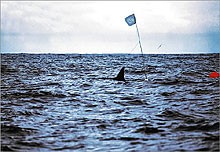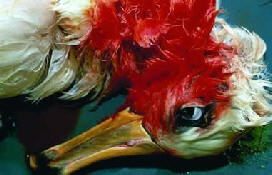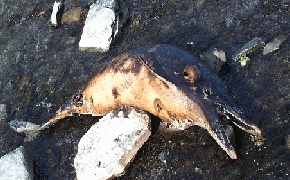|
Technologies to reduce sea bird mortalities do exist, including “bird scarers” and “underwater chutes”.
As sea bird bycatch generally occurs during setting and hauling the line, it is hoped that the underwater chutes will greatly reduce the high levels of sea bird bycatch.
First developed in 1995, the underwater setting chute releases baited hooks underwater, out of sight and reach of diving sea birds.
This technology has been tested in New Zealand, and is now undergoing trials in Australia's tuna longline fisheries.
However, underwater chutes will not reduce the bycatch levels of cetaceans, turtles, sharks and other marine species.
The actual scale of cetacean bycatch in longline fisheries in European waters is not known.
There is no compulsory monitoring system of European fishing vessels, and therefore the majority of scientific studies have focused on midwater / pelagic fisheries and gillnet fisheries, as the level of cetacean bycatch in these fisheries is known to be extremely high.
However, the information which is available demonstrates that a number of cetacean species
are "incidentally captured" in longline fisheries
in European waters: bottlenose dolphins,
common dolphins, striped dolphins,
Risso’s dolphins, orca, long-finned pilot whales,
minke whales and sperm whales.
In the United States, the Marine Mammal
Protection Act requires that fishing vessels are
monitored for levels of marine mammal bycatch,
and having estimated the levels for each fishery,
steps are taken to reduce the cetacean bycatch levels.
When longline fisheries in the Northwest Atlantic were monitored by US fisheries observers, it was found that a number of cetacean species were "incidentally captured" in longline fisheries: bottlenose dolphins, common dolphins, Atlantic spotted dolphins,Risso’s dolphins, orca, long-finned and short-finned pilot whales, minke whales and sperm whales.
http://www.nmfs.noaa.gov/prot_res/PR2/Stock_Assessment_Program/individual_sars.html
In order to ascertain the scale of cetacean bycatch in European longline fisheries, it is imperative that all longline fisheries in European waters should be monitored by independent observers.
A Cetacean Bycatch Response Team should then develop a Bycatch Response Strategy to reduce the number of cetaceans killed in longline fisheries.
There have been attempts to reduce cetacean bycatch
in a few longline fisheries.
Various acoustic devices have been used; changes have
been made in terms of soak times, the colour of the line
and branches, haul back speed, to name but a few.
All, to date, have had little effect.
|


